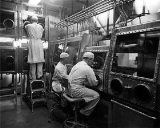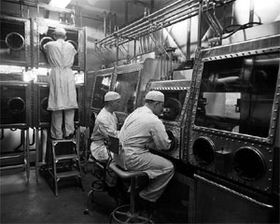
United States Army Biological Warfare Laboratories
Encyclopedia
The U.S. Army Biological Warfare Laboratories (USBWL) were a suite of research laboratories and pilot plant
centers operating at Camp (later Fort) Detrick
, Maryland
, USA beginning in 1943 under the control of the U.S. Army Chemical Corps Research and Development Command
. The USBWL undertook pioneering research and development into biocontainment
, decontamination
, gaseous sterilization, and agent production and purification for the U.S. offensive biological warfare program
. The Laboratories and their projects were discontinued in 1969.

requested the National Academy of Sciences
(NAS) in 1941 to review the feasibility of biological warfare (BW). The following year, the NAS reported that BW might be feasible and recommended that steps be taken to reduce U.S. vulnerability to BW attack. Thereafter, the official policy of the United States was first to deter the use of BW against U.S. forces, and secondarily to retaliate if deterrence failed.
, professor of bacteriology at the University of Wisconsin–Madison
, was scientific director of the Laboratories.
.
disestablished all offensive BW studies and directed the destruction of all stock piles of BW agents and munitions.
The USBWL was also a parent facility overseeing testing and production centers elsewhere, including:
Pilot plant
A pilot plant is a small chemical processing system which is operated to generate information about the behavior of the system for use in design of larger facilities....
centers operating at Camp (later Fort) Detrick
Fort Detrick
Fort Detrick is a U.S. Army Medical Command installation located in Frederick, Maryland, USA. Historically, Fort Detrick was the center for the United States' biological weapons program ....
, Maryland
Maryland
Maryland is a U.S. state located in the Mid Atlantic region of the United States, bordering Virginia, West Virginia, and the District of Columbia to its south and west; Pennsylvania to its north; and Delaware to its east...
, USA beginning in 1943 under the control of the U.S. Army Chemical Corps Research and Development Command
Chemical Corps (United States Army)
The Chemical Corps is the branch of the United States Army tasked with defending against Chemical, Biological, Radiological, and Nuclear weapons...
. The USBWL undertook pioneering research and development into biocontainment
Biocontainment
The concept of biocontainment, also called laboratory biosafety, pertains to microbiology laboratories in which the physical containment of highly pathogenic organisms or agents is required, usually by isolation in environmentally and biologically secure cabinets or rooms, to prevent accidental...
, decontamination
Decontamination
Decontamination is the process of cleansing the human body to remove contamination by hazardous materials including chemicals, radioactive substances, and infectious material...
, gaseous sterilization, and agent production and purification for the U.S. offensive biological warfare program
U.S. Biological Weapon Testing
The United States biological weapons program officially began in spring 1943 on orders from U.S. President Franklin Roosevelt. Research continued following World War II as the U.S. built up a large stockpile of biological agents and weapons. Throughout its history the program was secret...
. The Laboratories and their projects were discontinued in 1969.
History

Origins
The USBWL were created after Secretary of War Henry L. StimsonHenry L. Stimson
Henry Lewis Stimson was an American statesman, lawyer and Republican Party politician and spokesman on foreign policy. He twice served as Secretary of War 1911–1913 under Republican William Howard Taft and 1940–1945, under Democrat Franklin D. Roosevelt. In the latter role he was a leading hawk...
requested the National Academy of Sciences
United States National Academy of Sciences
The National Academy of Sciences is a corporation in the United States whose members serve pro bono as "advisers to the nation on science, engineering, and medicine." As a national academy, new members of the organization are elected annually by current members, based on their distinguished and...
(NAS) in 1941 to review the feasibility of biological warfare (BW). The following year, the NAS reported that BW might be feasible and recommended that steps be taken to reduce U.S. vulnerability to BW attack. Thereafter, the official policy of the United States was first to deter the use of BW against U.S. forces, and secondarily to retaliate if deterrence failed.
World War II
Throughout the war years, Dr Ira L. BaldwinIra Baldwin
Ira L. Baldwin was the founder and director emeritus of the Wisconsin Academy Foundation. He began teaching bacteriology at the University of Wisconsin–Madison, where he had done his doctoral work, in 1927, and a few years later moved into what became a long career in administration...
, professor of bacteriology at the University of Wisconsin–Madison
University of Wisconsin–Madison
The University of Wisconsin–Madison is a public research university located in Madison, Wisconsin, United States. Founded in 1848, UW–Madison is the flagship campus of the University of Wisconsin System. It became a land-grant institution in 1866...
, was scientific director of the Laboratories.
Cold War
The USBWL were the United States' front-line defense against BW during the first half of the Cold WarCold War
The Cold War was the continuing state from roughly 1946 to 1991 of political conflict, military tension, proxy wars, and economic competition between the Communist World—primarily the Soviet Union and its satellite states and allies—and the powers of the Western world, primarily the United States...
.
Disestablishment
In 1969, the USBWL ceased to exist when President Richard NixonRichard Nixon
Richard Milhous Nixon was the 37th President of the United States, serving from 1969 to 1974. The only president to resign the office, Nixon had previously served as a US representative and senator from California and as the 36th Vice President of the United States from 1953 to 1961 under...
disestablished all offensive BW studies and directed the destruction of all stock piles of BW agents and munitions.
Operations
At Fort Detrick, the USBWL consisted of various labs and divisions, including:- The Safety "S" Division, first to be activated (1943)
- Biological Protection Branch
- The Special Operations Division (1949–68), conducted hundreds of field tests of aerosolized simulants
- The Crops Division (called "Plant Sciences Laboratories" after 1966), evaluated thousands of compounds for herbicidal activity (including Agent OrangeAgent OrangeAgent Orange is the code name for one of the herbicides and defoliants used by the U.S. military as part of its herbicidal warfare program, Operation Ranch Hand, during the Vietnam War from 1961 to 1971. Vietnam estimates 400,000 people were killed or maimed, and 500,000 children born with birth...
; see Herbicidal warfareHerbicidal warfareHerbicidal warfare is a form of Chemical warfare in which the objective is to destroy the plant-based ecosystem of an area. In contrast to other forms, its use is not prohibited by international agreement...
)
The USBWL was also a parent facility overseeing testing and production centers elsewhere, including:
- Pine Bluff ArsenalPine Bluff ArsenalThe Pine Bluff Arsenal is a US Army installation located in Jefferson County, Arkansas, just northwest of the city of Pine Bluff. PBA is one of the six Army installations in the United States that store chemical weapons...
, ArkansasArkansasArkansas is a state located in the southern region of the United States. Its name is an Algonquian name of the Quapaw Indians. Arkansas shares borders with six states , and its eastern border is largely defined by the Mississippi River... - Horn IslandHorn Island (Mississippi)Horn Island is a long, thin barrier island off the Gulf Coast of Mississippi, south of Ocean Springs. It is part of the Gulf Islands National Seashore. Horn Island is several miles long, but less than a mile wide at its widest point...
, MississippiMississippiMississippi is a U.S. state located in the Southern United States. Jackson is the state capital and largest city. The name of the state derives from the Mississippi River, which flows along its western boundary, whose name comes from the Ojibwe word misi-ziibi... - Dugway Proving GroundDugway Proving GroundDugway Proving Ground is a US Army facility located approximately 85 miles southwest of Salt Lake City, Utah in southern Tooele County and just north of Juab County...
, UtahUtahUtah is a state in the Western United States. It was the 45th state to join the Union, on January 4, 1896. Approximately 80% of Utah's 2,763,885 people live along the Wasatch Front, centering on Salt Lake City. This leaves vast expanses of the state nearly uninhabited, making the population the...
, including Granite Peak InstallationGranite Peak InstallationGranite Peak Installation , also known as Granite Peak Range, was a U.S. biological weapons testing facility located on of Dugway Proving Ground in Utah. GPI was a sub-installation of Dugway but had its own facilities, including utilities... - Vigo Ordnance PlantVigo Ordnance PlantThe Vigo Ordnance Plant, also known as the Vigo Chemical Plant or simply Vigo Plant, was a U.S. Army facility built in 1942 to produce conventional weapons. In 1944 it was converted to produced biological agents for the U.S. bio-weapons program. The plant never produced any bio-weapons before the...
, near Terre Haute, IndianaIndianaIndiana is a US state, admitted to the United States as the 19th on December 11, 1816. It is located in the Midwestern United States and Great Lakes Region. With 6,483,802 residents, the state is ranked 15th in population and 16th in population density. Indiana is ranked 38th in land area and is...

